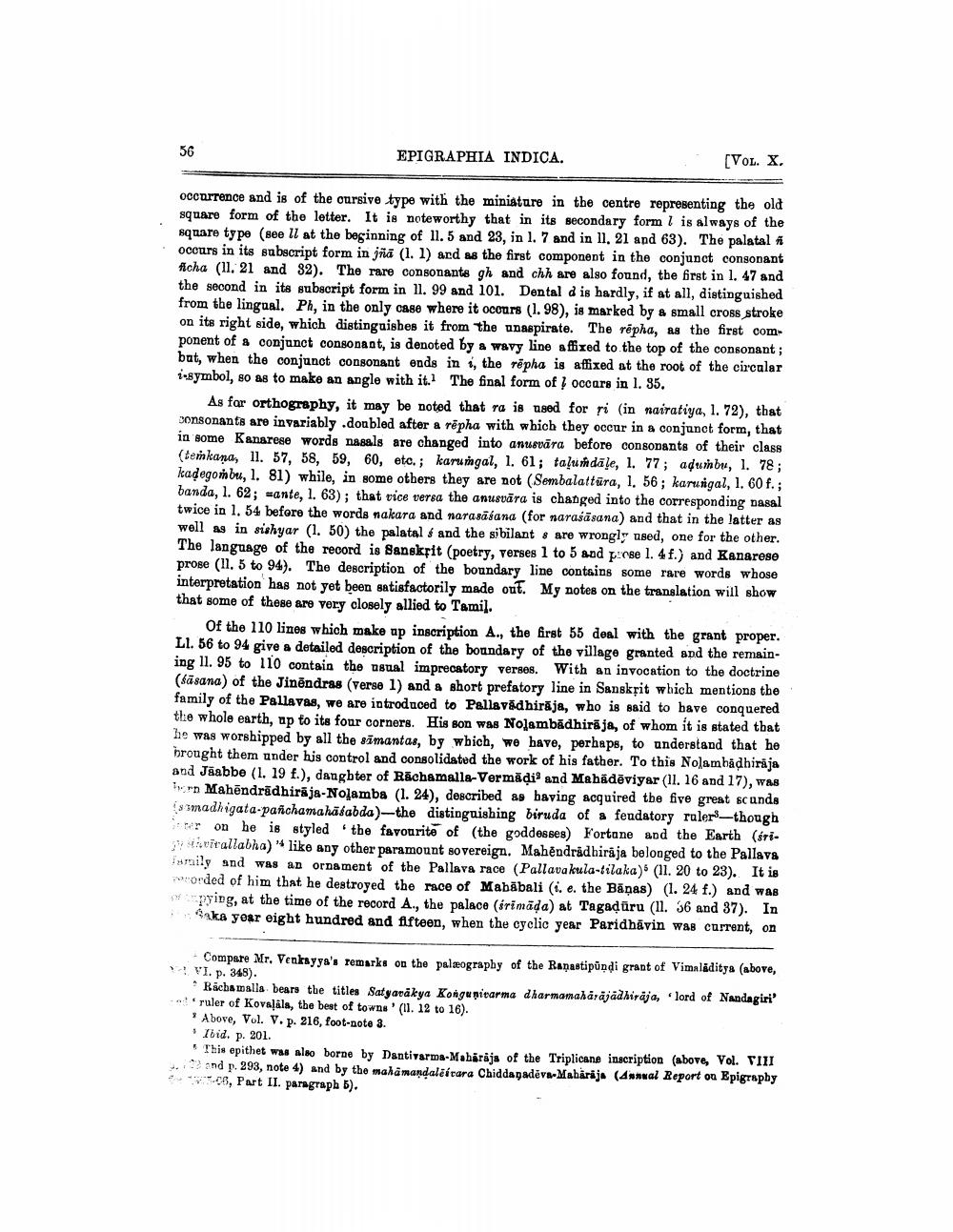________________
56
EPIGRAPHIA INDICA.
[VOL. X.
occurrence and is of the cursive type with the miniature in the centre representing the old square form of the letter. It is noteworthy that in its secondary form is always of the square type (see ll at the beginning of 11. 5 and 23, in 1. 7 and in 11, 21 and 63). The palatal occurs in its subscript form in jña (1. 1) and as the first component in the conjunct consonant ficha (11. 21 and 32). The rare consonants gh and chh are also found, the first in 1. 47 and the second in its subscript form in 11. 99 and 101. Dental d is hardly, if at all, distinguished from the lingual. Ph, in the only case where it occurs (1. 98), is marked by a small cross stroke on its right side, which distinguishes it from the unaspirate. The repha, as the first com ponent of a conjunct consonant, is denoted by a wavy line affixed to the top of the consonant; but, when the conjunct consonant ends in i, the repha is affixed at the root of the circular i-symbol, so as to make an angle with it. The final form of occurs in 1. 35.
As for orthography, it may be noted that ra is used for ri (in nairatiya, 1. 72), that consonants are invariably .doubled after a repha with which they occur in a conjunct form, that in some Kanarese words nasals are changed into anusvara before consonants of their class (temkana, 11. 57, 58, 59, 60, etc.; karumgal, 1. 61; talumdale, 1. 77; adumbu, 1. 78; kadegombu, 1. 81) while, in some others they are not (Sembalattura, 1. 56; karungal, 1. 60 f.; banda, 1. 62; ante, 1. 63); that vice versa the anusvära is changed into the corresponding nasal twice in 1. 54 before the words nakara and narasasana (for narasasana) and that in the latter as well as in sishyar (1. 50) the palatal and the sibilant s are wrongly used, one for the other. The language of the record is Sanskrit (poetry, verses 1 to 5 and prese 1. 4 f.) and Kanarese prose (11. 5 to 94). The description of the boundary line contains some rare words whose interpretation has not yet been satisfactorily made out. My notes on the translation will show that some of these are very closely allied to Tamil.
Of the 110 lines which make up inscription A., the first 55 deal with the grant proper. Ll. 56 to 94 give a detailed description of the boundary of the village granted and the remaining 11. 95 to 110 contain the usual imprecatory verses. With an invocation to the doctrine (sasana) of the Jinendras (verse 1) and a short prefatory line in Sanskrit which mentions the family of the Pallavas, we are introduced to Pallavadhiraja, who is said to have conquered the whole earth, up to its four corners. His son was Nolambadhiraja, of whom it is stated that he was worshipped by all the simantas, by which, we have, perhaps, to understand that he brought them under his control and consolidated the work of his father. To this Nolamhadhiraja and Jaabbe (1. 19 f.), daughter of Rachamalla-Vermaḍi and Mahadeviyar (11. 16 and 17), was Horn Mahendradhiraja-Nolamba (1. 24), described as having acquired the five great scunds madhigata-pañchamahāśabda)-the distinguishing biruda of a fendatory rulers-though er on he is styled the favourite of (the goddesses) Fortune and the Earth (éristhvivallabha) like any other paramount sovereign. Mahendradhiraja belonged to the Pallava family and was an ornament of the Pallava race (Pallavakula-tilaka) (11. 20 to 23). It is orded of him that he destroyed the race of Mahabali (i. e. the Banas) (1. 24 f.) and was pying, at the time of the record A., the palace (irimada) at Tagaḍuru (11. 36 and 37). In aka year eight hundred and fifteen, when the cyclic year Paridhavin was current, on
14
Compare Mr. Venkayya's remarks on the palæography of the Ranastipundi grant of Vimaladitya (above, VI. p. 348).
Rachamalla bears the titles Satyavakya Kongunivarma dharmamahārājädhiraja, lord of Nandagiri' ruler of Kovalala, the best of towns' (11. 12 to 16).
Above, Vol. V. p. 216, foot-note 3.
Ibid. p. 201.
This epithet was also borne by Dantivarma-Maharaja of the Triplicane inscription (above, Vol. VIII 9.23 and p. 293, note 4) and by the mahamandaleitara Chiddagadeva-Maharaja (Annual Report on Epigraphy 06, Part II. paragraph 5).




